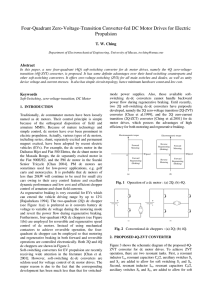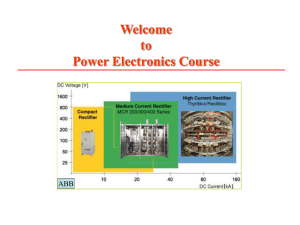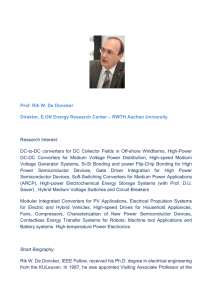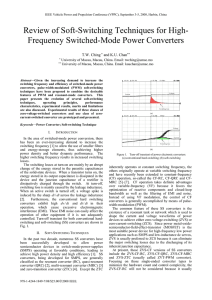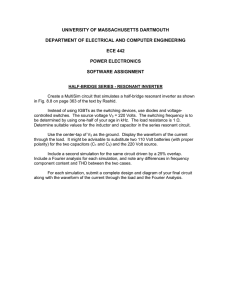Soft-switching Converters for Electric Vehicle Propulsion.pmd
advertisement
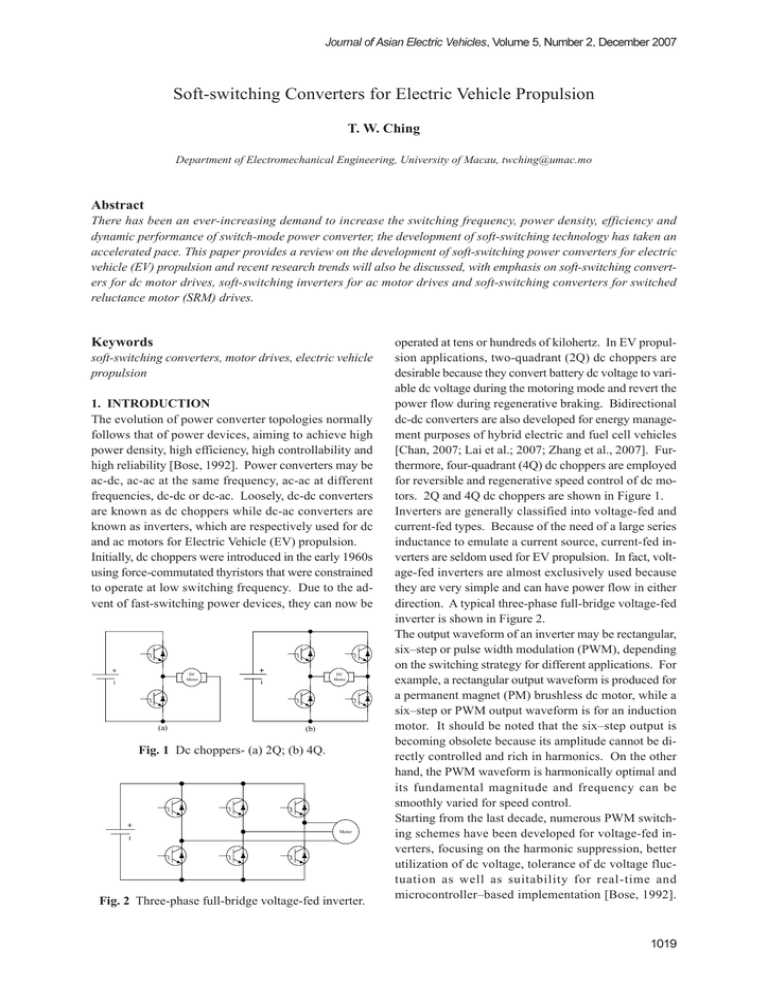
Soft-switching Converters for Electric Vehicle Propulsion T. W. Ching Department of Electromechanical Engineering, University of Macau, twching@umac.mo Abstract There has been an ever-increasing demand to increase the switching frequency, power density, efficiency and dynamic performance of switch-mode power converter, the development of soft-switching technology has taken an accelerated pace. This paper provides a review on the development of soft-switching power converters for electric vehicle (EV) propulsion and recent research trends will also be discussed, with emphasis on soft-switching converters for dc motor drives, soft-switching inverters for ac motor drives and soft-switching converters for switched reluctance motor (SRM) drives. Keywords soft-switching converters, motor drives, electric vehicle propulsion 1. INTRODUCTION The evolution of power converter topologies normally follows that of power devices, aiming to achieve high power density, high efficiency, high controllability and high reliability [Bose, 1992]. Power converters may be ac-dc, ac-ac at the same frequency, ac-ac at different frequencies, dc-dc or dc-ac. Loosely, dc-dc converters are known as dc choppers while dc-ac converters are known as inverters, which are respectively used for dc and ac motors for Electric Vehicle (EV) propulsion. Initially, dc choppers were introduced in the early 1960s using force-commutated thyristors that were constrained to operate at low switching frequency. Due to the advent of fast-switching power devices, they can now be DC Motor (a) DC Motor (b) Fig. 1 Dc choppers- (a) 2Q; (b) 4Q. Motor Fig. 2 Three-phase full-bridge voltage-fed inverter. operated at tens or hundreds of kilohertz. In EV propulsion applications, two-quadrant (2Q) dc choppers are desirable because they convert battery dc voltage to variable dc voltage during the motoring mode and revert the power flow during regenerative braking. Bidirectional dc-dc converters are also developed for energy management purposes of hybrid electric and fuel cell vehicles [Chan, 2007; Lai et al.; 2007; Zhang et al., 2007]. Furthermore, four-quadrant (4Q) dc choppers are employed for reversible and regenerative speed control of dc motors. 2Q and 4Q dc choppers are shown in Figure 1. Inverters are generally classified into voltage-fed and current-fed types. Because of the need of a large series inductance to emulate a current source, current-fed inverters are seldom used for EV propulsion. In fact, voltage-fed inverters are almost exclusively used because they are very simple and can have power flow in either direction. A typical three-phase full-bridge voltage-fed inverter is shown in Figure 2. The output waveform of an inverter may be rectangular, six–step or pulse width modulation (PWM), depending on the switching strategy for different applications. For example, a rectangular output waveform is produced for a permanent magnet (PM) brushless dc motor, while a six–step or PWM output waveform is for an induction motor. It should be noted that the six–step output is becoming obsolete because its amplitude cannot be directly controlled and rich in harmonics. On the other hand, the PWM waveform is harmonically optimal and its fundamental magnitude and frequency can be smoothly varied for speed control. Starting from the last decade, numerous PWM switching schemes have been developed for voltage-fed inverters, focusing on the harmonic suppression, better utilization of dc voltage, tolerance of dc voltage fluctuation as well as suitability for real-time and microcontroller–based implementation [Bose, 1992]. These schemes can be classified as voltage-controlled and current-controlled PWM. The state-of-the-art voltage-controlled PWM schemes are natural or sinusoidal PWM, regular or uniform PWM, harmonic elimination or optimal PWM, delta PWM, carrier-less or random PWM, and equal-area PWM. On the other hand, the use of current control for voltage-fed inverters is particularly attractive for high-performance motor drives because the motor torque and flux are directly related to the controlled current. The state-of-the-art current-controlled PWM schemes are hysteresis-band or band-band PWM, instantaneous current control with voltage PWM, and space vector PWM [Chan et al., 1997]. 2. REQUIREMENTS OF SOFT-SWITCHING CONVERTERS FOR EV PROPULSION Soft-switching converters for EV propulsion are recently receiving wide attention in the literature [Chan et al., 1997]. Instead of using hard or stressed switching, power converters can adopt soft or relaxed switching. The key of soft-switching is to employ a resonant circuit to shape the current or voltage waveform such that the power device switches at zero-current or zero-voltage condition. In general, the use of soft-switching converters possess the following advantages: – Due to zero-current or zero-voltage switching condition, the device switching loss is practically zero, thus giving high efficiency. – Because of low heat sinking requirement and snubber–less operation, the converter size and weight are reduced, thus giving high power density. – The device reliability is improved because of minimum switching stress during soft switching. – The EMI problem is less severe and the machine insulation is less stressed because of lower dv/dt resonant voltage pulses. – The acoustic noise is very small because of high frequency operation. On the other hand, their key drawbacks are the additional cost of the resonant circuit and the increased complexity. Although soft-switching dc-dc converters have been widely accepted by switched-mode power supplies, the corresponding development for EV propulsion is much slower. As the pursuit of power converters having high efficiency and high power density for EV propulsion is highly desirable, the development of soft-switching power converters for motor drives is in progress [Lai, 1997; Murai, 1997; Chau et al., 1999; Lai et al., 2005]. Table 1 gives a comparison between hard-switching and soft-switching converters for EV propulsion. Table 1 Comparison of hard-switching and soft-switching for EV propulsion. Hard–switching Soft–switching Switching loss Severe Almost zero Overall efficiency Norm Possibly higher Heat–sinking requirement Norm Possibly lower Hardware count Norm More Overall power density Norm Possibly higher EMI problem Severe Low dv/dt problem Severe Low Versatile Limited Maturity Mature Developing Cost Norm Higher Modulation scheme 3. SOFT-SWITCHING DC-DC CONVERTERS FOR EV PROPULSION There have been many soft-switching dc-dc converters developed for switched-mode power supplies [Chau et al., 1991; Chan et al., 1993; Chau, 1994; Hua et al., 1995; Ching, 2008], these converters cannot be directly applied to dc motors for EV propulsion. Apart from suffering excessive voltage and current stresses [Chong et al., 1993; Luo et al., 2000], they cannot handle backward power flow during regenerative braking [Uma et al., 2000]. It should be noted that the capability of regenerative braking is very essential for EVs as it can extend the vehicle driving range by up to 25%. In recent years, some soft-switching dc-dc converters have been specially developed for EV propulsion, which offers the capability of bidirectional power flow for both motoring and regenerative braking. 3.1 Zero-voltage multi-resonant converters fed dc motor drive A two-quadrant (2Q) zero-voltage multi-resonant (ZVMR) converter has been applied for dc motors drives [Chau et al., 1996]. The 2Q–ZV–MR converter is created by adding a resonant inductor and two resonant capacitors to a conventional 2Q–PWM dc drive, as shown in Figure 3. Major advantages of the 2Q–ZV– MR converter are as follows: – Constant frequency operation. – Utilization of all built-in diodes of the power switches and absorption of major parasitic. DC Motor Fig. 3 2Q–ZV–MR converter fed dc motor drive. – Zero-voltage-switching (ZVS) for all power switches. – Bidirectional power flow for both motoring and regenerative braking. – Full ranges of both voltage conversion ratio and load. – Short-circuit operation capability. However, the circulating energy and the conduction losses associated with the MR cell are significantly increased, hence the power rating of the power metal-oxide semiconductor field-effect transistor (MOSFET) are higher as compared with their PWM counterpart. 3.2 Zero-voltage-transition converters fed dc motor drive A 2Q zero-voltage-transition (ZVT) soft-switched dcdc converter has been developed for dc motor drives [Chau et al., 1999]. The 2Q-ZVT converter is created by adding a resonant inductor, a resonant capacitor and two auxiliary switches to a conventional 2Q-PWM dc drive, as shown in Figure 4. It should be noted that the ZVT technology is highly desirable for power MOSFET based power conversion. It is due to the fact that the power MOSFET device generally suffers from serve capacitive voltage turn-on losses. Major advantages of the 2Q-ZVT dc motor drive are as follows: – Zero-voltage-switching (ZVS) for all main switches and rectifiers. – Bidirectional power flow for both motoring and regenerative braking. – Unity device voltage and current stresses during both the motoring and regenerating modes of operation. – Same resonant tank for both forward and backward power flows. – Stray capacitances are utilized as part of the resonant components. – Utilization of all built–in diodes of the power switches, thus minimizing the overall hardware count and cost. DC Motor DC Motor Fig. 5 2Q-ZCT converter fed dc motor drive. two auxiliary switches to a conventional 2Q-PWM dc drive, as shown in Figure 5. This 2Q-ZCT converter is particularly useful for those high-power dc motor applications, employing the insulated-gate bipolar transistor (IGBT) as power devices, which generally suffer from diode reverse recovery during turn-on and severe inductive turn-off switching losses. Major advantages of the 2Q-ZCT dc motor drive are as follows: – Zero-current-switching (ZCS) for all switches and rectifiers. – Bidirectional power flow for both motoring and regenerative braking – Same resonant tank for both forward and backward power flows. 3.4 Four-quadrant zero-transition converters fed dc motor drive 4Q dc choppers are employed for reversible and regenerative speed control of dc motors. Instead of using mechanical contactors to achieve reversible operation, the 4Q dc chopper is employed so that motoring and regenerative braking in both forward and reversible operations are controlled electronically. Following the spirit of development on the 2Q-ZVT and 2Q-ZCT converters [Chau et al., 1999; Ching et al., 2001], 4Q-ZVT and 4Q-ZCT converters fed dc motor drives are recently developed [Ching, 2005; Ching, 2006], as shown in Figures 6 and 7 respectively. Major advantages of 4Q converters are similar to their 2Q counterparts. Fig. 4 2Q-ZVT converter fed dc motor drive. 3.3 Zero-current–transition converter fed dc motor drive A 2Q zero-current-transition (ZCT) soft-switched dcdc converter has been developed for dc motor drives [Ching et al., 2001]. The 2Q-ZCT converter is created by adding a resonant inductor, a resonant capacitor and DC Motor Fig. 6 4Q-ZVT converter fed dc motor drive. 1997]. The classification of soft-switching inverter in [Bellar et al., 1998; Pickert et al., 1999] is consolidated in Figure 9 [Ching, 2007]. The operating principles and performance characteristics of three soft-switching inverters suitable for EV propulsion are described in this section. Among them, the ARS inverter type is being actively developed for EV propulsion. DC Motor Fig. 7 4Q-ZCT converter fed dc motor drive. Soft switching inverters At present, most commercially available electric scooters and mini EVs utilize hard-switching dc-dc choppers for propulsion and they are widely accepted in densely populated cities in China, Taiwan, Japan and India. The development of soft-switching dc-dc converters for EV propulsion has a definite market value with a challenge to elevate the power level up to 5kW. Load resonant Parallel Series Motor Fig. 8 Three-phase voltage-fed RDCL inverter. Subsequently, many improved soft-switching topologies have been proposed, such as the quasi–resonant dc link (QRDCL), series resonant dc link (SRDCL), parallel resonant dc link (PRDCL), synchronized resonant dc link, resonant transition, auxiliary resonant commutated pole (ARCP), and auxiliary resonant snubber (ARS) inverters. A number of development goals of soft-switching inverters for EV propulsion have been identified, namely efficiency over 95%, power density over 3.5 W/cm3, switching frequency over 10-20 kHz, dv/dt below 1000 V/ms, zero EMI, zero failure before the end of the vehicle life. Recently, the delta-configured ARS version has satisfied most of these goals, and has been demonstrated to achieve an output power of 100 kW [Lai, Resonant link AC DC Parallel Quasi-resonant 4. SOFT-SWITCHING DC-AC INVERTERS FOR EV PROPULSION The development of soft-switching inverters for ac motors (including induction motors, PM brushless motors and PM hybrid motors [Chau et al., 2007]) has become a research direction in power electronics. Figure 8 shows a milestone of soft-switching inverters, namely the threephase voltage-fed resonant dc link (RDCL) inverter developed in 1989 [Divan, 1989]. Resonant transition ZVS ZCS Resonant snubber Series Soft-transition PWM ZVT ZCT Fig. 9 Classification of soft-switching inverters. 4.1 Resonant dc link inverter Figure 8 shows a basic resonant dc link (RDCL) inverter. In this circuit, the inverter input voltage is pulsating by adding a parallel resonant network between the dc voltage source and the inverter bridge, therefore the link voltage has zero crossings which create the desirable ZVS conditions for inverter switches. The peak resonating voltage is twice the dc source voltage under noload condition and more than three times the dc source voltage under the transition from motoring mode to regeneration mode. By adding an auxiliary switch and a stored-voltage clamp capacitor in the conventional RDCL [Divan, 1989], as shown in Figure 10, a better voltage clamping level of 1.3-1.5 times the dc source voltage can be achieved, but the additional components result in increased cost and reliability penalty. Major advantages of RDCL are as follows: Motor Fig. 10 Active clamped RDCL inverter. – – – – – – Minimum number of power devices. Elimination of snubbers. ZVS for main switches. Low dv/dt at motor terminals. High resonant as well as switching frequencies. Low sensitivity to parasitic impedance and device recovery effects. There are several improved versions based on the basic RDCL inverter. However, some technical problems remain unsolved, such as: – High voltage stress of 1.3-1.5 times the dc source voltage (even with clamping). – Pre-charging problem of the voltage clamp capacitor. – Rich in sub-harmonics due to discrete modulation. – High switching losses for the auxiliary switches and diodes. 4.2 Auxiliary resonant commutated pole inverter The auxiliary resonant commutated pole inverter (ARCP) or quasi-resonant inverter [Cho et al., 1998] shifts the resonant inductor away from the main power flow and connected to the split capacitors for bidirectional commutation, as shown in Figure 11. A bidirectional switch is series connected to the resonant inductor to control the direction of resonant energy transfer. These auxiliary switches are operated with ZCS and required to withstand only half of the dc source voltage. Since the auxiliary switches are not associated with any load energy transfer, their power ratings are much smaller than the main power devices. Main features of ARCP inverters are as follows: – Conventional PWM or space vector modulation (SVM) can be applied for controlling the ARCP. – Unity voltage/current stresses on main switches – Equivalent spectral performance to hard-switching converter. – Auxiliary switches are required to withstand half of the dc source voltage only. – ZVS for main switches while ZCS for auxiliary switches. However, some technical problems remain unsolved, such as: – System performance varies with load current. – Additional bulky energy storage capacitors are required. Motor Fig. 11 ARCP inverter. – Several split capacitors are required. – Long resonant period since only half dc source voltage is applied for resonance. 4.3 Auxiliary resonant snubber inverter An improvement of ARCP inverter, the resonant circuit of ARS inverter [McMurray, 1993; Lai, 1997] is placed between phase outputs, instead of using a centre tapped dc link for commutation. The principle of ARS inverter is to utilize the resonant capacitor across the device to achieve zero turn-off loss and the resonant inductor along with the auxiliary switches to achieve zero-voltage turnon. The auxiliary branch is connected between two phase legs. Circuit operation if ARS inverter is similar to ARCP inverter except its commutation relies on the interaction between at lease two phase-legs. By using auxiliary switches and resonant inductors along with resonant snubber capacitors to achieve the softswitching condition, two three-phase topologies of the ARS inverter are shown in Figure 12 and Figure 13. Motor Fig. 12 Delta-connected ARS inverter. Motor Fig. 13 Star-connected ARS inverter. Although this ARS inverter has promising applications to EV propulsion, it still needs continual improvement before practically applying to EVs. Particularly, the corresponding control complexity should be alleviated, while the corresponding PWM switching scheme needs to be modified to enable variable speed control of induction motor drives. Major features of ARS inverter are summarized as follows: – Minimum auxiliary components when compared with ARCP inverter and low cost. – Simple resonant inductor current control. – ZVS for main switches and ZCS for auxiliary switches. – Parasitic inductance and stray capacitance are utilized as part of the resonant components. – Comparatively less over-voltage or over-current penalty in main switches. – Modification of conventional PWM or SVM control strategies are required. 4.4 Soft-switching ac converters for switched reluctance motor drives Compared with the development of soft-switching inverters for ac motors, the development for switched reluctance motor (SRM) drives has been very little [Murai et al., 1997; Cho et al., 1997; Rolim et al., 1999], and suffered from limited research activities in recent years. In fact, motor manufacturers have little activities to further develop SRM and their drives. Nevertheless, two soft-switching converters, so-called the ZVT version and the ZCT version, have been particularly developed for SRMs. Figure 14 shows the ZVT converter for SRM drives [Ching et al., 1998]. It possesses the advantages that the main switches and diodes can operate at ZVS, unity device voltage and current stresses. As a counterpart, Figure 15 shows the ZCT converter for SRM drives [Chau et al., 1998]. It possesses the advantages that both the main and auxiliary switches are operate at ZCS, as well as minimum current and voltage stresses. 5. CONCLUSION Bidirectional zero–transition converters for dc motor drives possess the definite advantages of simple circuit topology and low cost, leading to achieve high switching frequency, high power density and high efficiency. Other key features are the use of the same resonant tank for both forward and backward power flows and the full utilization of all built-in diodes of the power switches, thus minimizing the overall hardware count and cost. RDCL inverters were the first soft-switching inverter reported in literature, and represent the beginning of significant research activity worldwide in this area. They are attractive because of their low component count. ARCP inverters use quasi-resonant technique to minimize inductor losses, however, the component count is high and therefore is relatively expensive when compared with hard-switching converters. Between the star-connected and the delta-connected inverter topologies, the delta-ARS inverter is relatively more attractive for EV propulsion because of the advantages of higher power capability, no floating-voltage or over-voltage penalty on the auxiliary power switches, no need of using additional voltage or current sensors, and no need of using anti-paralleled fast reverse recovery diodes across the resonant switches. Acknowledgements This paper is supported and funded by the Research Council of The University of Macau (RG063/06–07S/ CTW/FST). References SRM Ph. 1 Ph. 2 Ph. 3 Fig. 14 ZVT converter for SRM drives. SRM Ph. 1 Ph. 2 Ph. 3 Fig. 15 ZCT converter for SRM drives. Bellar, M. D., T. S. Wu, A. Tchamdjou, J. Mahdavi, and M. A. Ehsani, Review of Soft–switched DC–AC Converters, IEEE Transactions on Industry Applications, Vol. 34, No. 4, 847-860, 1998. Bose, B. K., Power Electronics: A Technology Review, Proceedings of IEEE, Vol. 80, No. 8, 1303-1334, 1992. Chan, C. C., and K. T. Chau, A New Zero-VoltageSwitching DC/DC Boost Converter, IEEE Transactions on Aerospace and Electronic Systems, Vol. 29, No. 1, 125-134, 1993. Chan, C. C., and K. T. Chau, An Overview of Power Electronics in Electric Vehicles, IEEE Transactions on Industrial Electronics, Vol. 44, No. 1, 3-13, 1997. Chan, C. C., The State of the Art of Electric, Hybrid, and Fuel Cell Vehicles, Proceedings of IEEE, Vol. 95, No. 4, 704-718, 2007. Chau, K. T., Y. S. Lee, and A. Ioinovici, Computer-aided Modeling of Quasi-Resonant Converters in the Presence of Parasitic Losses by Using MISSCO Concept, IEEE Transactions on Industrial Electronics, Vol. 38, No. 6, 454-461, 1991. Chau, K. T., New Constant-frequency Multi-resonant Boost Convertor, IEE Electronics Letters, Vol. 30, No. 2, 101-102, 1994. Chau, K. T., A New Class of Pulsewidth-modulated Multi-Resonant Converters Using Resonant Inductor Freewheeling, International Journal of Electronics, Vol. 77, No. 5, 703-714, 1994. Chau, K. T., T. W. Ching, and C. C. Chan, Constantfrequency Multi-resonant Converter-fed DC Motor Drives, Proceedings of IEEE International Conference on Industrial Electronics, Control, and Instrumentation, Vol. 1, 78-83, 1996. Chau, K. T., T. W. Ching, C. C. Chan, and M. S. W. Chan, A Novel Zero-Current Soft-Switching Converter for Switched Reluctance Motor Drives, Proceedings of Annual Conference of IEEE Industrial Electronics Society, Vol. 2, 893-898, 1998. Chau, K. T., J. M. Yao, and C. C. Chan, A New SoftSwitching Vector Control Approach for Resonant Snubber Inverters, International Journal of Electronics, Vol. 86, No. 1, 101-115, 1999. Chau, K. T., and T. W. Ching, A New Two-quadrant Zerovoltage Transition Converter for DC Motor Drives, International Journal of Electronics, Vol. 86, No. 2, 217-231, 1999. Chau, K. T., and C. C. Chan, Emerging Energy-efficient Technologies for Hybrid Electric Vehicles, Proceedings of IEEE, Vol. 95, No. 4, 821-835, 2007. Ching, T. W., K. T. Chau, and C. C. Chan, A New Zerovoltage-transition Converter for Switched Reluctance Motor Drives, Proceedings of IEEE Power Electronics Specialists Conference, Vol. 2, 1295-1301, 1998. Ching, T. W., and K. T. Chau, A New Two-quadrant Zerocurrent Transition Converter for DC Motor Drives, International Journal of Electronics, Vol. 88, No. 6, 719-735, 2001. Ching, T. W., Four-quadrant Zero-voltage-transition Converter-fed DC Motor Drives for Electric Propulsion, Journal of Asian Electric Vehicles, Vol. 3, No. 1, 651-656, 2005. Ching, T. W., Four-quadrant Zero-current-transition Converter-fed DC Motor Drives for Electric Propulsion, Journal of Asian Electric Vehicles, Vol. 4, No. 2, 911-918, 2006. Ching, T. W., Soft-switching Converters for Electric Propulsion, Proceeding of The 23rd International Electric Vehicle Symposium & Exposition, 2007. Ching, T. W., Review of Soft-switching Technologies for High-frequency Switched-mode Power Conversion, International Journal of Electrical Engineering Education, Paper No. 4042, 2008. Cho, J. G., W. H. Kim, D. W. Yoo, G. H. Rim, and K. Y. Cho, Novel Zero Voltage Transition PWM Converter for Switched Reluctance Motor Drives, Proceedings of IEEE Power Electronics Specialists Conference, Vol. 2, 887-891, 1997. Cho, J. G., J. W. Baek, D. W. Yoo, C. Y. Won, and G. H. Rim, Zero-voltage-switching Three-level Auxiliary Resonant Commutated Pole Inverter For High-power Applications, IEE Proceedings-Electric Power Applications, Vol. 145, No. 1, 25-32, 1998. Chong, C. C., C. Y. Chan, and C. F. Foo, A Quasi-resonant Converter-fed DC Drive System, European Conference on Power Electronics and Applications, Vol. 5, 372-377, 1993. Divan, D. M., The Resonant DC Link Converter-A New Concept in Static Power Conversion, IEEE Transactions on Industry Application, Vol. 25, No. 2, 317325, 1989. Divan, D. M., and G. Skibinski, Zero-switching-loss Inverters for High-power Applications, IEEE Transactions on Industry Applications, Vol. 25, No. 4, 634643, 1989. Hua, G., and F. C. Lee, Soft-switching Techniques in PWM Converters, IEEE Transactions on Industrial Electronics, Vol. 42, No. 6, 595-603, 1995. Lai, J. S., Resonant Snubber-based Soft-switching Inverters for Electric Propulsion Drives, IEEE Transactions on Industrial Electronics, Vol. 44, No. 1, 7180, 1997. Lai, J. S., and J. Zhang, Efficiency Design Considerations for a Wide-range Operated High-power Softswitching Inverter, Proceedings of Annual Conference of IEEE Industrial Electronics Society, 604-609, 2005. Lai, J. S., and D. J. Nelson, Energy Management Power Converters in Hybrid Electric and Fuel Cell Vehicles, Proceedings of IEEE, Vol. 95, No. 4, 766-777, 2007. Luo, F. L., and L. Jin, Two-quadrant DC/DC Soft-switching Converter, Proceedings of IEEE Power Electronics Specialists Conference, Vol. 1, 173-178, 2000. McMurray, W., Resonant Snubbers with Auxiliary Switches, IEEE Transactions on Industry Applications, Vol. 29, No. 2, 355-362, 1993. Murai, Y., J. Cheng, and M. Yoshida, A Soft-switched Reluctance Motor Drives Circuit with Improved Performances, Proceedings of IEEE Power Electronics Specialists Conference, Vol. 2, 881-886, 1997. Pickert, V., and C. M. Johnson, Three-phase Soft-switching Voltage Source Converters for Motor Drives. Part I: Overview and Analysis, IEE Proceedings-Electric Power Applications, Vol. 146, No. 2, 147-154, 1999. Rolim, L. G. B., W. I. Suemitsu, E. H. Watanabe, and R. Hanitsch, Development of an Improved Switched Reluctance Motor Drive Using a Soft-switching Con- verter, IEE Proceedings of Electric Power Applications, Vol. 146, No. 5, 488-494, 1999. Uma, G., and C. Chellamuthu, Modeling and Design of Fuzzy Speed Controller for Constant Frequency Zero Current Switched Converter Fed DC Servo Motor for Battery Operated Vehicles, Proceedings of International Conference on Power System Technology, Vol. 1, 211-215, 2000. Zhang, J., J. Lai, R. Y. Kim, and W. Yu, High-Power Density Design of a Soft-switching High-power Bidirectional DC-DC Converter, IEEE Transactions on Power Electronics, Vol. 22, No. 4, 1145-1153, 2007. (Received September 18, 2007; accepted November 26, 2007)
